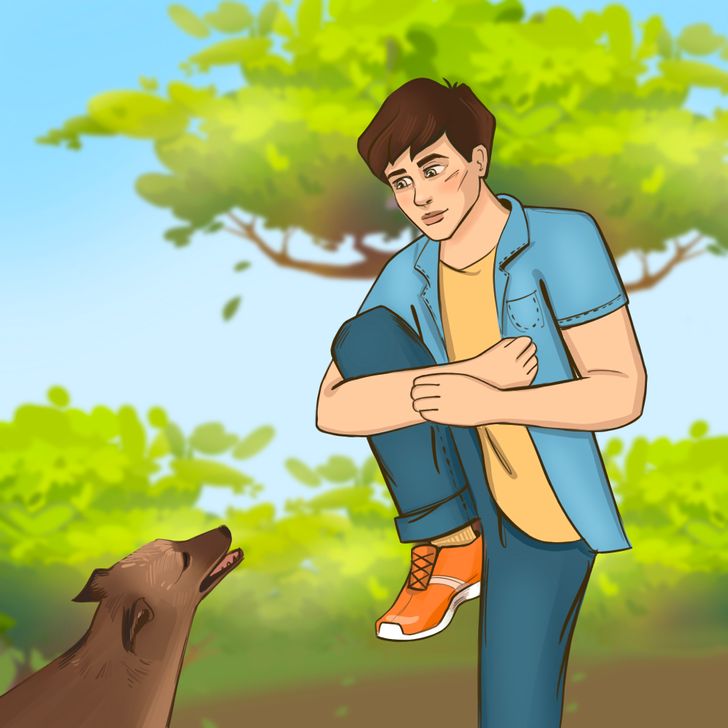Raise your leg and get bit in the privats
14 Survival Hacks That Can Bail You Out of Trouble

We never know what knowledge will come in handy if there is an emergency. This has been proven by a mother and her 10-year-old son who got lost in the Australian woodland for 10 days but managed to survive thanks to the tactics they had seen on TV.
We at Bright Side hope you never get into trouble in the first place, but just in case you do, here are some tips that will help you minimize the damage and maybe even save your life.
1. Being trapped in your car during a wildfire

If you’re caught inside of a car during a fire, try to find an area that is free of grass or other plants (which could be gravel or dirt). It’s imperative that you close all windows and vents, use something to cover yourself, and lie on the floor of your car. Know that the tires might burst because of high temperatures, but don’t panic. Simply wait in your vehicle until the fire passes.
2. Having to make a fire with no firestarter
If there’s nothing you can use to make a fire, don’t feel desperate: a plastic sandwich bag filled with water can help you. You should use it as a magnifying glass and concentrate the sunlight at a particular point with something highly flammable, like dry bark. You can find some video instructions on how to do this on YouTube.
3. Being attacked by a dog

Even though this situation is scary and dangerous, there are some tips you can use to minimize the damage. Stand up straight and say, “No!” in a firm voice — don’t scream or shout. If the dog is biting you, don’t try to pull the attacked body part out, try pushing it instead. Keep your fingers in fists to protect them. You can also raise your leg or even curl into a ball to protect your stomach and chest.
4. Getting struck by lightning in a tent
If you find yourself outside during a storm, avoid big trees since lightning is most likely to strike the tallest object (when it’s close to this object). Also, don’t set up camp right under the trees because their heavy branches might fall unexpectedly and lead to serious injuries.
5. Getting separated from the group in the dark
Before going into the woods, make sure that everyone in the group has glow sticks. These plastic tubes contain chemicals that release energy when they’re activated, which is then turned into light. In the scary scenario of a person getting separated from the rest of the party, the sticks will help you find them more easily. Standard glow sticks can be used for 8-12 hours.
6. Pitching a tent in a swamp
When looking for a place to set up your tent in a forest, avoid areas of smooth and soft soil with moss and no trees — this might be a swamp since some of them are saturated seasonally, and others might be covered with a bog with no visible water. If you stay there long enough, the tent might get wet or even drown.
7. Getting cold exposure injuries
If you’re stuck outside during winter, drink more water than you think you need: it’s essential for body temperature regulation. This is the reason why dehydration is among the factors that increase your chances of getting cold exposure injuries, such as hypothermia, frostbite, and more.
8. Falling into a tree well

If you like skiing or snowboarding, beware of so-called tree wells. The leaves and branches around the tree trunk create a hollow space hidden by the snow that you might fall into. Along with serious injuries that you might get from just the fall alone, you can get trapped in the snow and bushes and suffocate (and most people fall headfirst).
If this happens to you, make an airway around your face and do your best to get other people’s attention, as the chances of rescuing yourself in this situation are very low.
9. Getting rid of mosquitoes without insect repellent
It’s a well-known fact that mosquitoes are not just annoying little creatures that make your skin itchy — some of them transmit serious diseases, such as malaria and many others. However, you can defend yourself even if you forget to take your repellent with you or just prefer natural options. Throw thyme leaves onto the fire, and it will give you 85% protection from mosquitoes for up to 90 minutes.
10. Making fire in rainy weather
If you’re stuck in the woods while it’s raining and it’s hard to find any dry wood to make fire, the Swedish fire log will come in handy. You need to find quite a large log (about 30 inches tall and 12 inches wide) and cut into it using a chainsaw, almost dividing it into 4 parts (or more) but stopping about 3 quarters of the way through. Having done that, put kindling inside and light a fire.
The main advantage of the Swedish fire log is that you don’t have to constantly search for the new, dry wood — it’s self-feeding. Plus, it’s compact, long-lasting, and suits well for cooking.
11. Getting lost in the woods
In an extreme situation when you need to make a signal fire, it is best to add pine branches and something made of rubber to the flame. This will produce a lot of noticeable black smoke, and it will be easier to spot you. Also, it will not be confused with a regular campfire. However, just like with any other type of fire, be very careful with it.
12. Having to build a winter shelter with no materials

Snow can actually help you keep warm. Sounds counterintuitive, doesn’t it? But still, if there are no places to hide from the cold and wind during winter, use it to build a shelter. There are many options for that — and you can explore them here — but the main principle is to make a hole in deep snow (don’t forget about ventilation in the roof) and stay inside of it.
It will be significantly warmer on the inside because of your body heat, as snow is a good insulator.
13. Getting stuck in the snow in a car

If your vehicle gets stuck in the snow, try letting some air out of your tires. This way, the tires’ surface area touching the ground becomes bigger, and it will give you more grip. But don’t get carried away, especially if you don’t have a tire pump with you.
14. Having to walk on ice

Try to avoid walking on ice as much as you can, but if you absolutely have to, walk like a penguin. It means that you should make short, flat-footed steps and keep your arms out to catch the ice around you in case you suddenly fall.
Do you know anything that can come in handy in case of an emergency? Please share your tips in the comments!
Comments
The one thing I am terrible at while camping is staying hydrated. We have a (car) rooftop tent which is fantastic at keeping us dry, off the ground, and away from animals. The only issue is that I keep refusing to go to the bathroom in the middle of the night so I subconsciously (probably closer to consciously) drink less water. We camp in National Parks so we try not to keep bright lights on for very long. (I’m not a fan of the dark, even a lantern doesn’t remove any fear.) At least we have a portable toilet but nothing around it- sorry to talk about it but have you ever watched dogs be hyper-aware of their surroundings while going to the bathroom? I have way less survival instincts than my dog (that’s both sad and by design- I am trying to learn what I can for if something goes wrong while camping but I’m a “freeze” instead of fight or flight so I just really hope nothing bad happens) Oh by design I mean I don’t think many people naturally have excellent survival instincts like our ancestors did. If only 90s Girl Scouts taught me a single survival skill. Thanks for these tips- actually will make me hydrate much better as well as some other things.
Related Reads
I Refuse to Let My Boss Take Credit for My Work Again, So I Decided to Outsmart Him

I Refused to Go to Work After a Family Emergency—HR Got Involved

I Refused to Do Extra Work, and HR Tried to Punish Me

I Got Fired the Day Before My Vacation—And HR’s Policy Was Their Biggest Mistake

I Absolutely Refuse to Delay My Retirement to Save My Spoiled Daughter and Her Son

11 People Who Remind Us Kindness Takes a Moment, but Echoes Forever

My DIL Excluded Me From Our Family Trip Photos—But She Didn’t Expect My Revenge

10 Stories That Prove Kindness Costs Nothing Yet Heals Everything

12 People Who Mastered the Art of Keeping Their True Motives Hidden

10 Stories of Kindness That Show Angels Walk Among Us Every Second of Every Day

15 Stories That Prove Quiet Kindness Is the Strength the World Still Needs

I Refuse to Get a Lower Salary Than the Colleague I Trained








